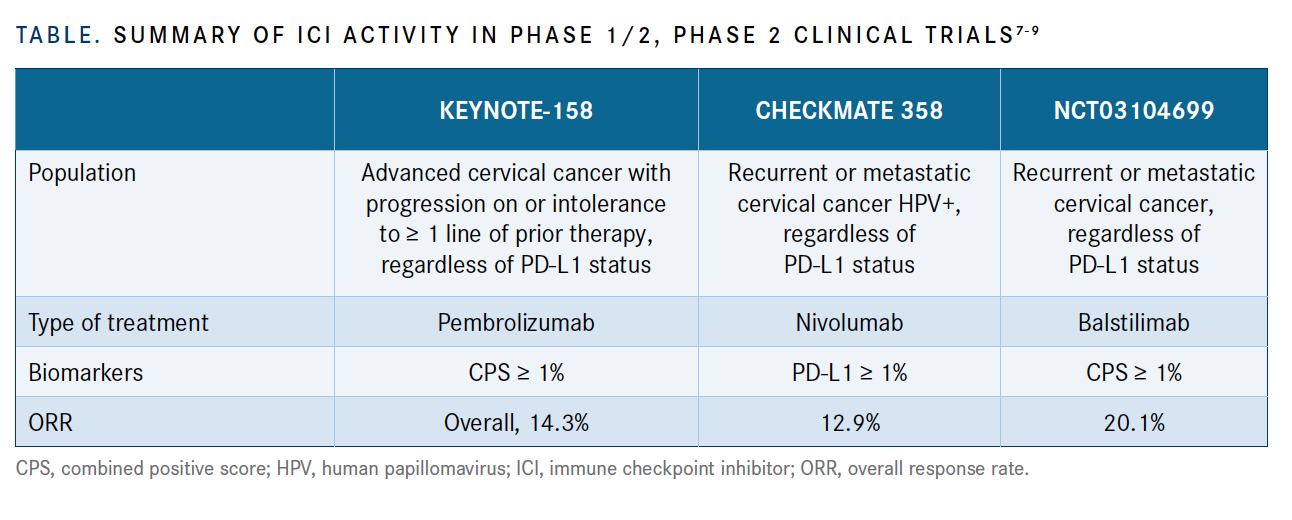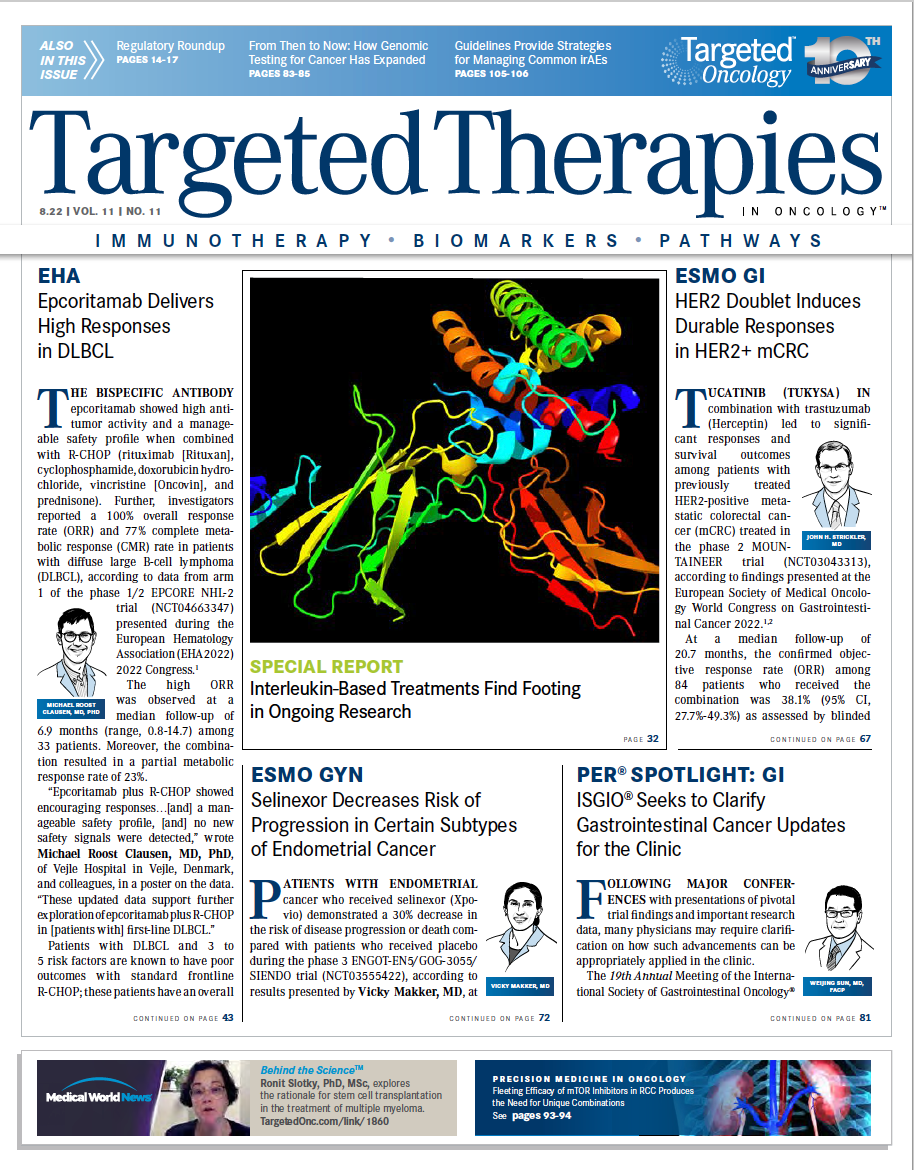Is PD-L1 an Appropriate Biomarker in Cervical Cancer?
Although PD-L1 expression has limitations as a predictive biomarker, it has nonetheless driven clinical decision-making.
Nicoletta Colombo, MD, PhD

Like other cancers, the use of immunotherapy in the treatment of locally advanced, recurrent, or metastatic cervical cancer has emerged over the past few years to include the frontline setting; however, there remains an unmet need for biomarkers to identify patients who may or may not respond.
Nicoletta Colombo, MD, PhD, director of gynecologic cancer medical treatments at the European Institute of Oncology and an associate professor of obstetrics and gynecology at the University of Milano-Biococca in Milan, Italy, and Ana Oaknin, MD, PhD, head of the Gynecological Tumor Unit and leader of the Gynaecological Cancer Program at the Institute of Oncology in Barcelona, Spain, provided a lively discussion on whether all patients with cervical cancer, regardless of biomarker status, should receive immunotherapy, during the European Society for Medical Oncology (ESMO) Gynaecological Cancers Congress 2022.1
Both investigators agreed that the crux of the matter revolves around having a reliable, specific, and sensitive biomarker to predict benefit from immunotherapy in cervical cancer.
Colombo, who argued for the use of immunotherapy, noted that there are currently 3 potential biomarkers undergoing evaluation in cervical cancer—PD-L1 expression, tumor mutational burden (TMB), and microsatellite instability (MSI). Although overlap exists between these 3 biomarkers regarding their presence in cervical cancer histology, there are potential gaps. For example, PD-L1 is less common in adenocarcinomas, whereas TMB is more common, and MSI is more common in adenosarcomas.2,3
Seeking to clarify the discussion further, Colombo emphasized that the better question is whether PD-L1 is the right biomarker to predict response to immunotherapy in cervical cancer, considering that both the FDA and European Medicines Agency recommended choosing patient candidates for immunotherapy based on companion testing for PD-L1 expression.4 Despite the regulatory approval, challenges continue with its use, including variability in preanalytical conditions, the use of different antibodies and staining platforms, and the lack of an unequivocal scoring system.
Oaknin, who is also principal clinical investigator of the Gynecological Malignancies Group at Vall d’Hebron Institute of Oncology in Barcelona, also emphasized these challenges, pointing out that PD-L1 expression has spatial and temporal heterogeneity and can be altered with exposure to prior therapies. Oaknin noted that both combined positive score and tumor proportion score are used in clinical trials to measure PD-L1 expression. Both investigators agreed that PD-L1 expression is an imperfect biomarker, but this was where their arguments diverged.
KEYNOTE-826 and EMPOWER
Two phase 3 clinical trials ascertained the role of PD-L1 status in cervical cancer: KEYNOTE-826 (NCT03635567) and EMPOWER-Cervical1/GOG-3016/ENGOT-cx9 (NCT03257267).5,6
In the KEYNOTE-826 trial, patients with persistent, recurrent, or metastatic cervical cancer were randomly assigned 1:1 to receive pembrolizumab (200 mg) or placebo every 3 weeks for up to 35 cycles. They also received platinum-based chemotherapy and, per investigator discretion, bevacizumab (Avastin).
Dual primary end points were progression-free survival (PFS) and overall survival (OS), which were each tested sequentially in patients with a PD-L1 combined positive score (CPS) of 1 or more, in the intention-totreat (ITT) population, and in patients with a PD-L1 CPS of 10 or more.
In the EMPOWER trial, patients who had disease progression after first-line platinum-containing chemotherapy were enrolled, regardless of their PD-L1 status. They were assigned 1:1 to receive cemiplimab (350 mg every 3 weeks) or investigator’s choice of single-agent chemotherapy. The primary end point was OS, and PFS and safety were also assessed.
Colombo emphasized that the 22C3 antibody was assessed in KEYNOTE-826 vs the SP263 antibody in EMPOWER. Further, KEYNOTE-826 used CPS with a threshold of less than 1%, between 1% and 10%, and 10% or greater compared with total positive score (TPS) with a threshold of 1% or greater in EMPOWER.
“A significant difference between these 2 trials is that patients enrolled in KEYNOTE-826 were tested prospectively because this was a stratification factor,” Colombo said. “Patients in EMPOWER were tested retrospectively using a different antibody and using a different methodology [than in KEYNOTE-826].”

In KEYNOTE-826, when comparing PFS in the ITT population vs in patients with a PD-L1 CPS greater than 1, the PFS curves were similar. Similar findings were elucidated when looking at OS, said Colombo. Objective response rate and duration of response were similar in the PD-L1 population with CPS 1 or greater, in the all-comer population, and in the PD-L1 population with CPS 10 or greater.
Because the PFS and OS curves were similar, “why should we select a patient [or not select] a patient [based on biomarker analysis]? What is the difference?” Colombo asked the audience. “To speculate on the lack of benefit on a small population of patients is both scientifically and methodologically incorrect,” she stated.
“Further, we know that [immunotherapy] improves PFS, OS, duration of response, and quality of life,” Colombo continued. “Why would we deny the benefit of immunotherapy…based on an imperfect test? There is solid evidence of benefit in the overall population for all primary end points.”
EMPOWER
Turning to EMPOWER, this second-line trial did not evaluate patients prospectively, and patients were enrolled regardless of PD-L1 expression. The investigators evaluated cemiplimab-rwlc (Libtayo) vs investigator’s choice chemotherapy, which could be pemetrexed, gemcitabine, topotecan, irinotecan, or vinorelbine.
In the median follow-up of 18.2 months (range, 6.0-38.2), median OS in the cemiplimab group (n = 304) was 12.0 months (95% CI, 10.3-13.5) vs 8.5 months (95% CI, 7.5-9.6) in the control group (n = 304; HR, 0.69; 95% CI, 0.56-0.84; 1-sided P = .00011).
Examining the OS in the squamous cell population (SCC) and the adenocarcinoma (AC) population, investigators reported a benefit. “Even the adenocarcinoma population reported a benefit in OS with the use of cemiplimab, despite the fact that PD-L1 expression was 71% in patients with SCC and 33% in patients with AC.6 So would you deny the benefit to patients because they had a negative PD-L1 expression?” Colombo asked.
Based on data from KEYNOTE-826 and EMPOWER, Colombo said immunotherapy resulted in improvements in PFS, OS, and quality of life in the overall population. She conceded that current biomarkers are imperfect but that selecting patients based on imperfect biomarkers will deny a potential benefit to those with a poor prognosis.
“Until better biomarkers [are] defined, all patients with cervical cancer should be offered the potential benefit of immunotherapy,” concluded Colombo.
The Argument Against PD-L1 as a Biomarker
Arguing against the use of PD-L1 expression as a biomarker for immune checkpoint inhibitor (ICI) efficacy, Oaknin pointed out 3 clinical trials for consideration: the phase 2 KEYNOTE-158 (NCT02628067),7 the phase 1/2 CheckMate358 (NCT02488759),8 and a phase 1/2 safety and efficacy study evaluating balstilimab (NCT03104699; TABLE).9
“When we look at the overall response rates, they range from 14% with pembrolizumab in the KEYNOTE-158 trial, [to] 26% with nivolumab in CheckMate358, and 15% with balstilimab [in the phase 1/2 study],” Oaknin said. But evaluating the response rate according to PD-L1 status, for nivolumab and balstilimab, investigators reported responses with PD-L1 negative disease, albeit lower responses compared with PD-L1 positive disease.
“However, when we look at KEYNOTE-158, in patients whose tumors are PD-L1 negative, the responses were zero,” Oaknin said. “Pembrolizumab didn’t show any kind of activity in this group of patients. These results were a trigger because the FDA approved pembrolizumab in patients with recurrent metastatic cervical cancer, and platinum failed only for patients whose tumors expressed CPS positivity as determined by an FDA approved test.”10
Oaknin also highlighted KEYNOTE-826 and EMPOWER findings. KEYNOTE-826 was designed to assess PFS and OS in patients with a CPS of 1 or greater, all comers, and those with a CPS of 10 or greater. EMPOWER assessed OS in the SCC and ITT populations. “Although both studies met their primary end points, key subgroup analysis has led to discussions about the benefit of ICIs in all patients with cervical cancer,” Oaknin said.
In prespecified subgroups evaluating PFS benefit in the ITT population, patients with a PD-L1 CPS of less than 1 had an HR of 0.94 (95% CI, 0.52-1.70). “This finding means that pembrolizumab doesn’t add benefit t a standard of care in those patients whose tumors are PD-L1 negative,” Oaknin said. Similarly, OS benefit for patients with a PD-L1 CPS less than 1 had an HR of 1.00 (95% CI, 0.53-1.89).
Turning to EMPOWER findings, Oaknin noted that patients had previously received platinum therapy and were enrolled regardless of PD-L1 status, emphasizing that the trial missed its primary end point. She said that in an exploratory analysis of the data, there was a clear separation in curves among patients who received cemiplimab and who were PD-L1 positive vs patients who received chemotherapy and whose tumors were PD-L1 positive.
Oaknin identified 3 reasons that PD-L1 is not a relevant biomarker: inconsistency, biological plausibility, and replication. She noted
differences in treatment effects according to PD-L1 subgroups in all efficacy outcomes, and provided a biological explanation to understand the predictive effect of PD-L1 with ICI treatments. In support of replication, similar conclusions can be drawn from KEYNOTE-826 and EMPOWER. Because not all patients benefit from immunotherapy and because PD-L1 is an imperfect biomarker, Oaknin suggested that TMB could be used, citing findings from KEYNOTE-158.
Although PD-L1 expression has limitations as a predictive biomarker, it has nonetheless driven clinical decision-making. “There is a real necessity to identify those patients who gain the most benefit by using a combination of biomarkers,” Oaknin concluded.
REFERENCES:
1. Colombo N. Shall all patients regardless of biomarker status receive immunotherapy in cervical cancer? Presented at: ESMO Gynaecological Cancers Congress 2022; June 17-18, 2022; Valencia, Spain and Virtual. Accessed July 18, 2022. https://bit.ly/3PEDxWD
2. Luchini C, Bibeau F, Ligtenberg MJL, et al. ESMO recommendations on microsatellite instability testing for immunotherapy in cancer, and its relationship with PD-1/PD-L1 expression and tumour mutational burden: a systematic review-based approach. Ann Oncol. 2019;30(8):1232-1243. doi:10.1093/annonc/mdz116
3. Vanderwalde A, Spetzler D, Xiao N, Gatalica Z, Marshall J. Microsatellity instability status determined by next-generation sequencing and compared with PD-L1 and tumor mutational burden in 11,348 patients. Cancer Med. 2018;7(3):746-756. doi:10.1002/cam4.1372
4. Davis AA, Patel VG. The role of PD-L1 expression as a predictive biomarker: an analysis of all US Food and Drug Administration (FDA) approvals of immune checkpoint inhibitors. J Immunother Cancer. 2019;7(1):278. doi:10.1186/s40425-019-0768-9
5. Colombo N, Dubot C, Lorusso D, et al; KEYNOTE-826 Investigators. Pembrolizumab for persistent, recurrent, or metastatic cervical cancer. N Engl J Med. 2021;385(20):1856-1867. doi:10.1056/NEJMoa2112435
6. Tewari KS, Monk BJ, Vergote I, et al; Investigators for GOG Protocol 3016 and ENGOT Protocol En-Cx9. Survival with cemiplimab in recurrent cervical cancer. N Engl J Med. 2022;386(6):544-555. doi:10.1056/NEJMoa2112187
7. Chung HC, Ros W, Delord JP, et al. Efficacy and safety of pembrolizumab in previously treated advanced cervical cancer: results from the phase II KEYNOTE-158 study. J Clin Oncol. 2019;37(17):1470-1478. doi:10.1200/JCO.18.01265
8. Naumann RW, Hollebecque A, Meyer T, et al. Safety and efficacy of nivolumab monotherapy in recurrent or metastatic cervical, vaginal, or vulvar carcinoma: results from the phase I/II CheckMate 358 trial. J Clin Oncol. 2019;37(31):2825-2834. doi:10.1200/JCO.19.00739
9. O’Malley DM, Oaknin A, Monk BJ, et al. Phase II study of the safety and efficacy of the anti-PD-1 antibody balstilimab in patients with recurrent and/or metastatic cervical cancer. Gynecol Oncol. 2021;163(2):274-280. doi:10.1016/j.ygyno.2021.08.018
10. FDA approves pembrolizumab for advanced cervical cancer with disease progression during or after chemotherapy. FDA. Updated June 13, 2018. Accessed July 20, 2022. https://bit.ly/3RPX73S
